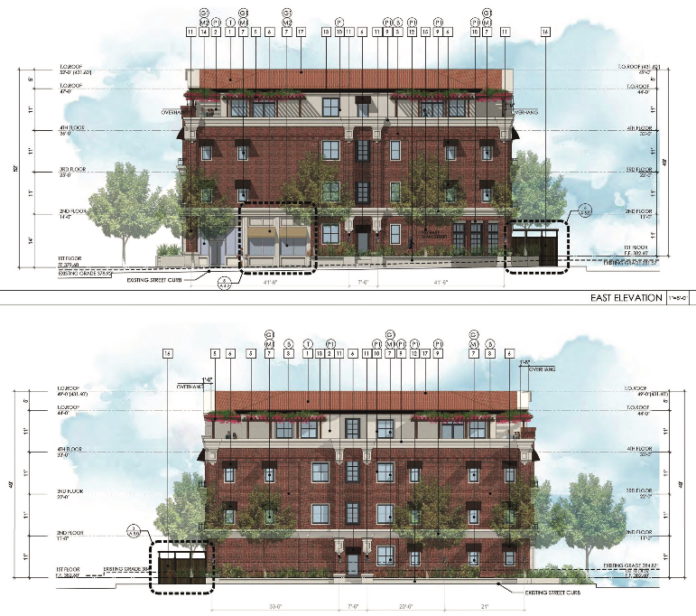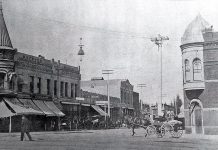At the May 27 Council meeting, Los Gatos approved the first by-right residential project that invoked the “Builder’s Remedy” tool meant to chastise the municipality for not handing in a compliant Housing Element on time.
While the four-story condo building with commercial space on the ground floor won praise across the board for its attention to design (quite the feat in the architecturally-fastidious locale), a significant rift opened up between those who thought the Los Gatos High School-adjacent setup was a great way to promote pedestrian and cycling lifestyles, and those who fear the new residents will increase congestion and make an already dangerous intersection worse.
“We have the opportunity to have housing in an area that would be very desirable for people to live in,” said Councilmember Maria Ristow, who voted to approve, noting that Los Gatos is still required to build about 2,000 more units in the next few years. “This is a small drop in the bucket. This is 30 units.”
The “Builder’s Remedy” is a State measure that prevents jurisdictions without a substantially compliant housing element from rejecting some housing projects, even if they don’t fall in line with its General Plan or zoning rules.
While the 155-unit Los Gatos Lodge redevelopment originally invoked the Builder’s Remedy, by the time it was approved March 4, the developer opted to use other methods to secure entitlements.
After the 3-2 vote (with Councilmember Mary Badame and Mayor Matthew Hudes opposed) the Los Gatan asked a developer’s representative how they felt about being the first successful Builder’s Remedy applicant, but he declined to comment.
The 143-151 E. Main St. project is known as the “Cafe Dio – Proposal 2,” after the Verve Coffee-serving business (tied-in with onetime Michelin Guide-honored Greek restaurant, Dio Deka, across the street) on the eastern side of the one-story structure with terra cotta roofing.
Six of the multifamily-style homes are to be developed as lower-income units. This is the number the developer had to include to hit a 20% threshold (the method they used to qualify for Builder’s Remedy).
A traffic study was completed even though it wasn’t required (because the site had been deemed able to handle a certain amount vehicular flow related to office use, and the new homes wouldn’t change things that much).
The consultant (Hexagon) determined the new project will reduce traffic at particular times of day (compared to if offices here saw full use).

Or, as staff reported, “the proposed project would generate approximately 17 new average daily trips, but fewer trips than the existing land use (Small Office Building) during the AM and PM peak hours…The trip generation study…shows that there would be one new ‘out’ trip in the AM peak hours, but that the rest of the trips would be less, resulting in no increase in overall peak hour trips.”
The Planning Commission took two meeting dates to recommend the development (in a 4-2 vote), so, the drama was heightened because there was still the ability to force the developer to make changes (provided Council could tie the demand to previously-agreed-upon rules that are objective in nature and not subjective).
See, under Builder’s Remedy, the Town has to deal with the project in no more than five hearings—otherwise it gets approved automatically.
So, there was a push from some quarters to find a reason to—if not necessarily deny the project outright—force a tweak that could shift it slightly more towards their liking.
Residents brought up factors such as wildfire evacuation routes, and the fact the area already gets locked into LA-style gridlock due to student pickup and drop-off traffic and because of Santa Cruz-bound beach traffic.
But, due to Hexagon’s assertion that traffic wasn’t going to be made that much more terrible, even if all the units are occupied, these couldn’t be deployed to force the developer to go back to the drawing board.
However, Mayor Hudes was able to confirm setbacks can be considered an objective standard for the purpose of ensuring health and safety.
‘I can’t think of another Builder’s Remedy project that would have as much of an adverse impact’
—Mayor Matthew Hudes
And, while the building design actually increased setbacks in some areas, the footprint was over the line elsewhere.
On March 11, Jim Lyon, a Johnson Avenue resident, emailed the Town in hopes it could somehow make the developer build three stories instead of four—and push it back further from the street.
“I recognize these requests may be overridden by the State Builder’s Remedy Law,” he wrote in this digital letter to Town planner Ryan Safty. “Thank you for your thorough review of the project on behalf of the Town. The developer has created an architecturally attractive design with commendable style and detail.”
Cathleen Bannon, a parent of two LGHS students, told the Town, March 3 in an email, she believes the proposed building would “create madness” in the already congested neighborhood.
“This building would unnecessarily cause chaos,” she said. “Again, too big in the most congested area of town.”
(She conceded, “…yes the building does look like the town, but the size & placement is too much”.)
Just weeks ago, another upscale California municipality fighting residential development, the City of La Cañada Flintridge, abandoned its appeal of a decision that stated it had incorrectly determined a project didn’t quality under Builder’s Remedy (—but only after it was told to put up a $14 million bond to move forward).
The case, California Housing Defense Fund v. City of La Cañada Flintridge, was included in the Agenda Packet, so Los Gatos Council members would be aware of the latest precedent (i.e. just how futile taking one of these expensive legal battles has proven for municipalities in Los Gatos’ position).
Reuben, Junius & Rose, LLP Partner, Thomas P. Tunny wrote in a blog post that that La Cañada Flintridge (which has a $42 million budget) “likely will have to pay the petitioners’ attorney’s fees, and the developer may recover millions in losses incurred due to the appeal. Local jurisdictions seeking to continue old strategies of baselessly denying housing projects will have to think twice going forward about the potential costs.”
Hudes’ language against the Cafe Dio condos got stronger throughout the hearing.
“I can’t think of another Builder’s Remedy project that would have as much of an adverse impact,” he said, as the body prepared to vote. “I think it’s dangerous. And I think without addressing the sightline, we have a hazardous and dangerous situation that will result in serious issues over there.”
Councilmember Rob Rennie said he hadn’t heard a valid reason to deny the project, or require revisions.
“I’m not buying into the site distance thing,” he said, noting that those making a left turn onto East Main Street (presumably the most dangerous scenario) won’t have their view obstructed from westbound traffic—because that’s where the school lawn is. “The traffic is not getting worse than the existing allowed uses.”
Hudes reopened the public hearing to allow the developer to respond to a question from Vice Mayor Rob Moore about the implications of holding the line on setbacks.
The developer said if forced to set the building back further from the road, they’d have no choice but to build additional stories—the last thing most Los Gatos residents want.
Ristow made the motion to approve, which was seconded by Moore.
After the hearing, Badame told the Los Gatan she thought the approval was premature.
“We’re allowed five meetings for Builder’s Remedy projects,” she said, referencing the Town’s objective standards. “I had hoped for a continuance to allow for refinement of the project.”










